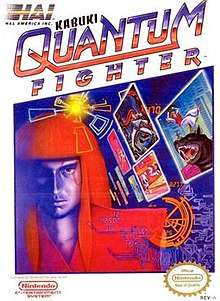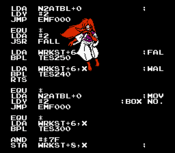Kabuki: Quantum Fighter
| Kabuki: Quantum Fighter | |
|---|---|
 North American cover art | |
| Developer(s) | Human Entertainment |
| Publisher(s) | |
| Composer(s) |
Masaki Hashimoto Takahiro Wakuta |
| Platform(s) | Nintendo Entertainment System |
| Release | |
| Genre(s) | 2D action platformer |
| Mode(s) | Single-player |
Kabuki: Quantum Fighter (地獄極楽丸 Jigoku Gokurakumaru) is a 2D action platformer video game developed by Human Entertainment and published by the defunct American publishing arm of HAL Laboratory for the Nintendo Entertainment System. It was originally released on December 21, 1990, in Japan and was released in January 1991 for the North American market before being released in Europe on February 20, 1992.
Plot

Players adopt the persona of 25-year-old Colonel Scott O'Connor, a military agent who has transferred his brain into raw binary code in order to combat a rogue program in the main defense computer. When O'Connor enters the system, his body forms the self-image of his ancestor, who was a kabuki actor.
In the year 2056, a virus has appeared in the main defense computer of the planet Earth. The origin and nature of the virus is unknown. Scott O'Connor volunteers to undergo an experimental transfer technology that converts his brain into raw binary code. He takes on the image of a Kabuki dancer, since the computer recognizes his great-grandfather as one. The virus in the virtual world takes on properties of an actual virus-it leaves behind debris, mutant creatures, and parasite environments of a biological nature. At the final level, it is revealed that the virus is of alien origin, having been picked up by a lost Hyperion probe launched to a neighboring planet. O'Connor stops it before the virus can order the Hyperion to fire its laser weapons and destroy the human population.
Gameplay
The field is generally side-scrolling, with a single room with a boss at the end of each level. Connor uses his long hair and chip-based weaponry to attack enemies inside the computer. The chip-weaponry includes the Energy Gun, Fusion Gun, Quantum Bombs and Remote-Controlled Bolo.
Regional differences
The Family Computer version was designed as a tie-in to the 1990 Kaizo Hayashi film Zipang. In this version, a boy named Bobby Yano transforms into his samurai ancestor, Jigoku Gokurakumaru, when entering a supercomputer.[1] References to the film were removed in the international releases.
References
- ↑ Human. Jigoku Gokurakumaru. Family Computer. Level/area: Game introduction.